International Journal of Computer Network and Information Security @ijcnis
Статьи журнала - International Journal of Computer Network and Information Security
Все статьи: 1177
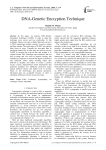
DNA-Genetic Encryption Technique
Статья научная
In this paper, we propose DNA-Genetic Encryption Technique (D-GET) in order to make the technique more secure and less predictable. In this technique, binaries any type of digital data and convert it to DNA sequencing, reshape, encrypt, crossover, mutate and then reshape. The main stages of D-GET are repeated three times or more. Transmit the encrypted data in text/image format file. In other side, the receiver uses the D-GET to decrypt the received data and reshape it to original format. This Technique also transforms the text into an image and vice versa to improve security and multiple key sequences to increase the degree of diffusion and confusion, which makes resulting cipher data difficult to decipher and makes to realize a perfect secrecy system. Experimental results demonstrate that proposed technique has multilayer protection stages against different attacks and higher level of security based on the multi-stages and genetic operations. Decrypted data are acceptable because of there is absolutely difference between it and secret data.
Бесплатно
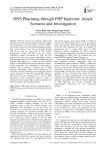
DNS Pharming through PHP Injection: Attack Scenario and Investigation
Статья научная
With the increase in technology, Internet has provided set of tools and technologies which has enabled web programmers to develop effective websites. PHP is most widely used server side scripting language and more than twenty million of web sites are designed through PHP. It has used as a core script in Web Content Management System (WCMS), such as Joomla, WordPress, Drupal, SilverStripe etc. PHP has also security flaws due to the certain vulnerabilities such as PHP injection, remote file inclusion and unauthorized file creation. PHP injection is a variant of code injection attacks in which PHP script may be exploited to execute remote commands. The contribution of this paper is twofold: First, it presents a unifying view of PHP injection vulnerability, which causes alteration in the 'hosts file'; Second, It introduces an investigation process against alteration in 'hosts file' through PHP injection. This attack has been introduced as a type of DNS pharming. In this investigation process a chain of evidence has been created and an algebraic signature has been developed to detect explained attack.
Бесплатно
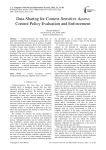
Data Sharing for Context-Sensitive Access Control Policy Evaluation and Enforcement
Статья научная
Context-awareness has long been an important building block in designing systems that vary their operating behavior based on an analysis of rapidly changing operating conditions. There is the need however to define context more formally so that context data-sharing can take place between systems and more complex interactions between connected systems can be developed. The area of computer security is examined in particular as an area where the representation and sharing of context data can lead to more effective policy enforcement. A framework is proposed for sharing data between assessment sensors and enforcement mechanisms in order to facilitate more accurate policy enforcement. A detailed performance analysis of the proposed system is offered along with conclusions on the feasibility of such systems.
Бесплатно
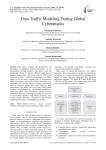
Data Traffic Modeling During Global Cyberattacks
Статья научная
The article analyses the possibilities and techniques of modeling global cyber-attacks on an internetwork of small countries. The authors study the Distributed Denial of Service (DDoS) attack against Estonian internetwork, which took place in 2007, in an open-source Nessi2 simulator environment, as DDoS appears to be the most common type of informational attack on resources used todeay. Such a modeling can be replicated with a certain degree of accuracy because the most of powerful attacks have been relatively well-documented. The article covers the most lifelike attack scenarios accomplished by sophisticated modeling of underlying traffic cases. Conclusions drawn from the simulation show that even large-scale DDoS attacks can be successfully modeled using limited resources only. Future research directions, motivated by the research, underlying this article, are highlighted at the end.
Бесплатно
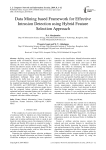
Статья научная
Building strong IDS is essential in today’s network traffic environment, feature reduction is one approach in constructing the effective IDS system by selecting the most relevant features in detecting most known and unknown attacks. In this work, proposing the hybrid feature selection method by combining Mutual Information and Linear Correlation Coefficient techniques (MI-LCC) in producing the most efficient and optimized feature subset. Support Vector Machine (SVM) classification technique being used in accurately classifying the traffic data into normal and malicious records. The proposed framework shall be evaluated with the standard benchmarked datasets including KDD-Cup-99, NSL-KDD, and UNSW-NB15 datasets. The test results, comparison analysis and reference graphs shows that the proposed feature selection model produces optimized and most important features set for classifier to achieve stated accuracy and less false positive rate compared with other similar techniques.
Бесплатно
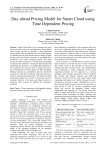
Day-ahead Pricing Model for Smart Cloud using Time Dependent Pricing
Статья научная
Smart clouds allow every consumer and cloud service provider a two-way communication, thus enabling cloud service provider to generate a time dependent pricing model using a feedback loop. This model charges a consumer more in peak periods and less during off peak periods, which encourages consumers to reschedule their workload to less traffic (off-peak) periods. This helps service providers to practice a versatile pricing technique to increase their profits by covering off-peak demand and minimizing the provider's cost optimization problem. It also minimizes the execution time in setting these prices by Compromised Cost-Time Based (CCTB) scheduling. Shifting workload is a probabilistic function which tells consumers to shift their workload. This paper presents a model to calculate day-ahead prices. The proposed model dynamically adjusts the rewards or discounts based on consumer behavior in the past, and helps providers to maximize their revenue by shifting the consumers' workload.
Бесплатно
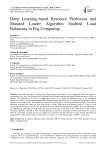
Статья научная
Load balancing plays a major part in improving the performance of fog computing, which has become a requirement in fog layer for distributing all workload in equal manner amongst the current Virtual machines (VMs) in a segment. The distribution of load is a complicated process as it consists of numerous users in fog computing environment. Hence, an effectual technique called Mutated Leader Algorithm (MLA) is proposed for balancing load in fogging environment. Firstly, fog computing is initialized with fog layer, cloud layer and end user layer. Then, task is submitted from end user under fog layer with cluster of nodes. Afterwards, load balancing process is done in each cluster and the resources for each VM are predicted using Deep Residual Network (DRN). The load balancing is accomplished by allocating and reallocating the task from the users to the VMs in the cloud based on the resource constraints optimally using MLA. Here, the load balancing is needed for optimizing resources and objectives. Lastly, if VMs are overloaded and then the jobs are pulled from associated VM and allocated to under loaded VM. Thus the proposed MLA achieved minimum execution time is 1.472ns, cost is $69.448 and load is 0.0003% respectively.
Бесплатно
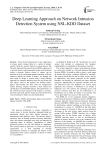
Deep learning approach on network intrusion detection system using NSL-KDD dataset
Статья научная
The network infrastructure of any organization is always under constant threat to a variety of attacks; namely, break-ins, security breach or system misuse. The Network Intrusion Detection System (NIDS) employed in a network detects such penetration attacks and intrusions within a network. Known classes of attacks can be detected easily by performing pattern matching while the unknown attacks are harder to detect. An attempt has been made to design a system using a deep learning approach for intrusion detection that not only learns but also adjusts itself to the patterns not defined earlier. Sparse auto-encoder has been used for unsupervised feature learning. Logistic classifier is then utilized for classification on NSL-KDD dataset. The performance of the system has been measured with respect to accuracy, precision and recall and the results have been found to be very promising for future use and modifications.
Бесплатно
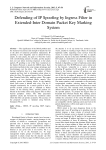
Defending of IP Spoofing by Ingress Filter in Extended-Inter Domain Packet Key Marking System
Статья научная
The significance of the DDoS problem and the increased occurrence and strength of attacks has led to the dawn of numerous prevention mechanisms. IP spoofing is most frequently used in denial-of-service attacks. In such attacks, the goal is to flood the victim with overwhelming amounts of traffic, and the attacker does not care about receiving responses to the attack packets. IP spoofing is one of the basic weaknesses in the Internet Protocol to launch the DDOS attack. Each prevention mechanism has some unique advantages and disadvantages over the others. The existing methods become ineffective due to a large number of filters required and they lack in information about where to place the filter. We propose Ingress filter in Extended Inter Domain Packet Key marking system .This paper comprises of two functional blocks namely, Key marking system and filtering blocks. In the marking block, each source is labeled with a key. The key is changed continuously for a certain period of time to provide secured system and is validated at border routers. In the filtering block, spoofed packets are filtered at the border router using Ingress filter to filter beyond periphery routers. The filter placement algorithm clearly put forwards the conditions under which the filter can operate accurately. The accuracy of the proposed systems is validated using Network Simulator (NS-2).
Бесплатно
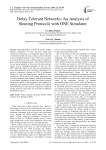
Delay Tolerant Networks: An Analysis of Routing Protocols with ONE Simulator
Статья научная
Delay/disruption Tolerant Networks (DTNs) provide connectivity in those networks which lack continuous connectivity or considerable delays like that of terrestrial mobile networks, military ad-hoc networks, sensor or planned network in space. They lack in an end-to-end path between Source and Destination resulting in long variable propagation delays. The Internet Protocols do not operate properly in these networks, thus raising a variety of new challenging problems in this area. The DTN effectively improves the network communications where the connectivity in the network is intermittent or is prone to disruptions. Routing in DTNs is challenging because of long and frequent time durations of non-connectivity. There are several routing approaches that have been proposed with strategies ranging from flooding to forwarding approaches. In this paper these protocols are analyzed based on the quantitative data gathered by simulating each protocol in ONE simulator environment. The performance is discussed and compared for different routing protocols and results are discussed for different performance metrics.
Бесплатно
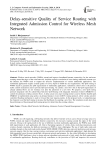
Статья научная
Wireless mesh networks (WMNs) extend and improve broadband Internet connectivity for the end-users roaming around the edges of the wired network. Amid the explosive escalation of users sharing multimedia content over the Internet, the WMNs need to support the effective implementation of various multimedia applications. The multimedia applications require assured quality of service (QoS) to fulfill the user requirements. The QoS routing in WMNs needs to guarantee the QoS requirements of multimedia applications. Admission control (AC) is the primary traffic control mechanism used to provide QoS provisioning. AC admits a new flow only if the QoS requirements of already admitted flows are not violated, even after the admission of a new flow. We propose a new QoS routing protocol integrated with AC called Delay-Sensitive QoS Routing with integrated Admission Control (DSQRAC) to control the admission of delay-sensitive flows. A delay-aware cross-layer routing metric is used to find the feasible path. DSQRAC is implemented using ad-hoc on-demand distance vector (AODV) routing protocol, where a delay-sensitive controlled flooding mechanism is used to forward the route request packets. In the proposed work, we adjust/reassign the channels to aid the QoS routing to increase the likelihood of accepting a new flow. The simulation results show that the performance of the proposed QoS routing protocol is better than the existing schemes.
Бесплатно
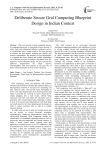
Deliberate Secure Grid Computing Blueprint Design in Indian Context
Статья научная
The novel concept of grid computing, clusters of computational power is constructed from a network of many small and widespread different computers servers or workstations into a single resource. We now proceed to translate the grid security problem into specific grid security requirements. The purpose of Grid technologies is to support the secure sharing and scalable coordinated use of diverse resources in dynamic, distributed VOs. We propose a secure blueprint design for grid systems that addresses requirements for single sign-on, interoperability with local policies of any grid city of India, with dynamically varying resource demands.
Бесплатно
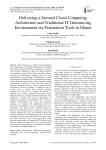
Статья научная
The decision to use either Cloud Computing (CC) applications or Traditional Information Technology Outsourcing (Traditional ITO) environments is a function of the security evaluations of these two options. Hackers are constantly nosing around websites and other computer networks for compromised computers that have some vulnerabilities to exploit them. Vulnerabilities in cloud computing and Traditional ITO environments are leading causes of recent data breaches. These breaches provide opportunities to hackers to attack and gain access to customer information such as credit cards and contact information, passwords, sending of malicious codes to website users or making users computer potential candidates of botnets and to hijack the sessions of authentic users to make unapproved purchases on their behalf. In this paper, security penetration tools have been employed to evaluate the security vulnerabilities of cloud-based solutions and Traditional ITO to discover possible vulnerabilities, their causes and mitigation strategies to securing web applications from the discovered vulnerabilities. Some web applications and a Traditional ITO network were ethically hacked to discover vulnerabilities in them. Analyses of the results obtained through the ZAP scan flagged Remote File Inclusion (RFI) alert were high priority alert. In all, RFI constitutes the most serious potential threat and it needs the fullest attention of CC service providers. Nmap disclosed opened ports in Traditional ITO Virtual Private Network which can make the server of the provider accessible to hackers leading to a considerable disclosure of information to unauthorized users.
Бесплатно
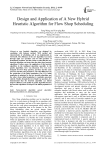
Design and Application of A New Hybrid Heuristic Algorithm for Flow Shop Scheduling
Статья научная
A new heuristic algorithm was designed by combining with Johnson method, NEH method and characteristics of scheduling, and it was implemented on MATLAB. The efficiency of the new algorithm was tested through eight Car questions and two Hel questions of Benchmark problems, and the results revealed that the new heuristic algorithm was better than the other three heuristic algorithms. Further more; the application of this heuristic algorithm in the intelligent algorithm especially in the genetic algorithms (GA) was discussed. Two GAs were designed for Flow Shop question, and they had the same processes and the same parameters. The only difference is in the production of the initial population. One GA’s initial population is optimized by the new heuristic algorithm, and the other whose initial population is randomly generated entirely. Finally, through the test of eight Car questions, it is demonstrated that the heuristic algorithm can indeed improve efficiency and quality of genetic algorithm because the heuristic algorithm can improve the initial population of GA.
Бесплатно
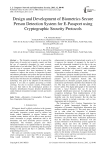
Статья научная
The biometric passports are to prevent the illegal entry of traveler into a specific country and limit the use of counterfeit documents by more accurate identification of an individual. This IC chip is integrated into the cover of a passport, called a biometric passport. Biometric Passports have been introduced in many countries to improve the security in Inspection Systems and enhance procedures and systems that prevent identity and passport fraud. The electronic passport is the privacy and security risks that arise by embedding with biometric technology. The goal of the adoption of the biometric passport is not only to expedite processing at border crossings, but also to increase security. Policymakers have put their faith in the technological promise of biometric identification because absolute identification could eliminate mismatched computer records and stolen identities.
Бесплатно

Статья научная
With the development of web technology, spreading of Trojan and viruses via website vulnerabilities is becoming increasingly common. To solve this problem, we propose a system for malicious links detection based on security relevance of webpage script text and present the design and implementation of this system. Firstly, according to the current analysis of malicious links, we describe requirements and the general design for detection system. Secondly we describe the security-related algorithm with mathematical language, and give the data structure of this algorithm. Finally, we analyze and summarize the experimental results, and verify the reliability and rationality of system.
Бесплатно

Design and Implementation of Adaptive Universal Filtered Multi Carrier for 5G and Beyond
Статья научная
The current generation (5G) mobile communication system promises to accommodate a wide range of new applications and use scenarios, resulting in more flexible and unified connection. To satisfy the required criteria, the current waveform was replaced with new UF-OFDM, which combines the advantages of OFDM with enhanced spectral characteristics and greater resilience against time-frequency misalignments. However, its biggest disadvantage is the transmitter's computational complexity, which may be up to two hundred times that of OFDM if there is no reduction in complexity. The majority of current research on unique waveforms has focused on filter modification or performance enhancement strategies. UFMC with the use of adaptive filter (UFMC -FSK) is offered as a revolutionary technique in this study. The filter designed and used to transport information through the index modulation technique. As a result, each UF-OFDM sub band's used filter is chosen, so the data rate is enhanced according to a filter configured depending on original input data bits. The combined Maximum-likelihood (ML) decision metric for each sub band that is calculated at the receiver. Each sub band has a filter as well as data symbols that provide the minimal metric for making decisions are discovered. Furthermore, the bit error rate and power spectrum density are enhanced over the UF-OFDM technique, however there is some trade-off. Overall, the proposed system outperform typical UF-OFDM. Matlab simulations are used to assess the performance of the Adaptive UFMC system.
Бесплатно

Design and Implementation of Reliable Encryption Algorithms through Soft Error Mitigation
Статья научная
Designing a reliable system on reconfigurable devices has become a significant factor for implementing mission critical applications like communication protocols, automotive, nuclear reactor control, and remote applications. With the improvement in fabrication technology, logic density of the field programmable gate arrays has increased rapidly. Because of decrease in feature size, integrated circuits are becoming vulnerable to errors and also the ageing component results in run time faults. FPGAs when used in harsh conditions like high radiation and temperatures, there is a possibility of getting affected by transient faults or the soft errors. In digital communication, safety and confidentiality of data is achieved through a suitable encryption algorithm. Encryption is most important aspect when it comes to security. Reliable design techniques are very much necessary for maintaining the system’s normal function. Many of the available techniques are based on redundancy logic causing area overhead for the design. Through this paper, an implementation is illustrated for managing soft errors or the single event upsets. Proposed methodology identifies and avoids the errors occurring at the logic resources where the encryption algorithms are mapped on the device. Thus encryption algorithms work normally without getting affected by the errors. During the simulation process, errors are injected at the configuration memory frames and monitored using a Single event-upset manager (SEM) controller. The proposed design is implemented on Zedboard using Xilinx Vivado 2017.4.
Бесплатно

Статья научная
Field programmable gate arrays (FPGAs) are the reconfigurable logic devices which are widely used in many applications like space missions, automotive electronics, complex computing systems and system prototyping. Run time reconfigurability feature supported in high end FPGAs allows the designer to optimize design with respect to resource utilization and power consumption. Using partial reconfiguration a specific part of the FPGA can be reconfigured at run time without altering the original design. In data communication, safety and confidentiality of data is achieved through a suitable encryption algorithm. Encryption is most important aspect when it comes to security. Design flexibility can be increased by providing an option to the user to select a particular algorithm as per the requirement. Instead of using a single algorithm to encrypt data, multiple algorithms can be used with an option to switch between the algorithms. Thus optimizing the resource utilization and also can avoid security breach. Through this work, an attempt is made to include reconfiguration of the design at run-time. This design implements different encryption algorithms at different instance of time. In this paper two encryption algorithms i.e. Advance Encryption Standard (AES) and TwoFish both of 128-bit are chosen to reconfigure at runtime using a custom ICAP (Internal Configuration Access Port) controller IP provided by Xilinx and is implemented on Zedboard. Main advantage of this implementation is that the user have an option to switch between two algorithms, thus helping in overall resource optimization.
Бесплатно

Статья научная
In the last decades, monitoring cameras begin to play a vital role in securing sensitive systems such as government sites or establishments. Generally, these kinds of cameras are fixed-location (i.e. outdoor camera) such that the viewpoint is limited to small area and not covering the whole place. In addition, there are some drawbacks that appear when using these kinds of cameras such as being breakable (intentionally or not) which may lead to camera malfunction or breaking in the linked electrical wires that may cause disconnection between the camera, monitor and its receiver. However, the main problem is the lacking of secure protecting system that prevents intruders from entering into the system disabling or malfunction it. In this research a new system is proposed in order to solve these problems by using wireless-mobile camera with embedded programmable operating system which enables controlling this camera remotely by sending wireless commands through the embedded component called Arduino card controller. This card enables the connection between the camera and the server to be programmatic by the user or developer. The main goal of this research is to design a monitoring system to detect any suspicious events and to ensure that the transferring monitoring data from the camera to the server is not infiltrated by unauthorized person by applying a set of techniques from image detection, object tracking and security algorithms to the instructions or the program of the camera. Compared with other researches, this work achieved the following goals: 1- Using Arduino card for programming the camera. 2- IP camera does not require user name and password. 3- The images and the other information are (encrypted) when sending to/from computer, 4- Using Mobile-wireless camera. 5- Process of keys exchanging between camera and computer. The results of this research are good and achieved the main goals of new developed technique.
Бесплатно

